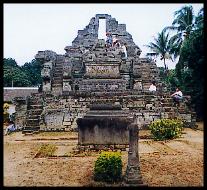

Kidal, Badut, Besuki, Singosari, Dvarapala, Watu Gede, Sumberawan, Songgoriti, Jago.
This temple is situated in the village of Rejokidal, with 30 km of Malang on the road of Tumpang. Built in 1260, it is the funerary temple, of 12 m 50 top of the 2nd king de Singosari : Anushapati, died in 1248. It is the best example of the architectural perfection of the religious art of the time of Singosari, with its fine presence, hurled, outcome with a roof in pyramid. Its diagram is traditional. With the principal sanctuary faces on the same platform three other sanctuaries. The whole of space is determined by nine points materialized by small linggam. The whole is locked up in a doubled enclosure, even tripled sometimes . It is a reconstitution of the Meru mount ; the temple is the residence of the god.
Candi
Kidal is a vishnuist sanctuary , like all those related to the Singosari dynasty,
which call on the spirit of this divinity. One finds there several representations
of the bird Garuda, the mounting of Vishnu, in a stringcourse which makes the
turn of the base and which tells episodes of the creation of the world. On the
southern face, Garuda carries the snake Seisha which was rolled up around the
Meru mount preceding the "churning of the milk sea". On the east face
, Garuda holds the bottle containing the elixir of immortality. On the northern
face, Garuda carries Lakshmi.
Built
into 750, this temple was restored in 860 then entirely remakes
in 1250. Its architecture is similar to constructions of Gedong
Songo, but in much larger. Temple shivaist dating from the time
of king Gajayana or Sang Liswa of the kingdom of Kanjuruhan.
One finds
on this temple the famous image of Durga Mahishasuramardini.
This
site is situated 600 m north of Candi Badut.
Unfortunately, only few stones can be seen here, groupped in two
structures. One finds a statue of Agastya in this place.
Built at the end of the 13th century to honour Kartanegara, last king de Singosari assassinated at the time of a revolt of the palace in 1392, it is located at 10 km in the north of Malang. The temple was preserved from destruction because king de Mojopahit came here, in 1359, to pay homage to its ancestors. The temple remained unfinished and only is top is decorated. This temple, of cruciform plan, is characteristic of the evolution of the rite at the end of the 13th century.
The small linggam which marked the limits of the sanctuaries are replaced by statues representatives of Dikpala, the guards of space.
This temple is devoted to the worship of Shiva Bhairava, whose one image was sheltered in the cella. It is a démoniaque, naked form with the eyes exorbities, the projecting teeth, holding a dagger and a cranial dish, it overlaps a jackal. On each sides of the porch were in niches images of Nandishvara and Mahakala. On the three others faces, one finds the usual images of Durga, Ganesha and of Agastya.
It is here that the representation preserved best of Prajnaparamita was found, the goddess of Supreme Wisdom. The goddess sat in perfect concentration, the stem of lotus intertwining the left hand, she makes the gesture of the actuation of the wheel of the law, the flower of lotus supports her attribute, the book of the transcendantal wisdom..
Many steles representing of divinized kings and queens, with attributes semi-shivaites, semi-vishnuites, three-pronged forks, rosaries, conches, are scattered in the court of the temple.
300
m after Candi Singosari, you can see deux big statues - 3 m 70
high- of gardians of the directions.
The site is situated at Singosari, on the right side of the road Malang Gempol, 100 m north of the railways station, in the village of Watu Gede.
It
is a big brick pool built in the 14th century. The pool is
surrounded by statues of Prajnaparamita
wearing a jar from which water flowed out.
This
temple of the end of the 14th century, is located in a park at 6
km at the northwest of the precedent in the village of Sumberawan
on the slopes of the Arjuna mount at 650 m of altitude. It is one
of both stupas, still visible, of east Java . The other Is Candi
Jabung. This place is described in
Nagurakertagama like "the garden of the celestial
nymphs". All the high part of the temple unfortunately
disappeared.
This little temple is situated in the garden of the hotel Songgoriti, at the boundary of the village of the same name, few kilometers after Batu.
We can see only the base with some parts of walls which shown many decorations, in particular sculptures of goddess most probably binded to water and prosperity.
In
fact, at the center of the cella, appears a squarred well which
collected water of the surrounding mounts.
Some
others statues or bits of statues are also visibles, but hard to
recognise. Nevertheless, we can see the base of a statue of Durga
with just her two feet and the buffalo demon upon which she was
stand up.

The narrative reliefs of the Candi Jago.
![]()